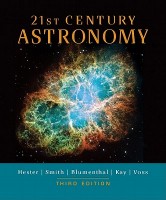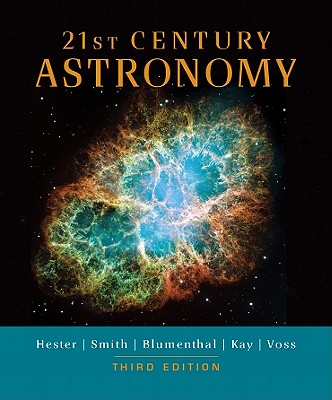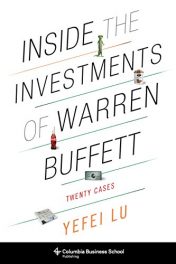 Authors: Jeff Hester, Brad Smith, George Blumenthal, Laura Kay, and Howard Voss
Authors: Jeff Hester, Brad Smith, George Blumenthal, Laura Kay, and Howard Voss
Publisher: W.W. Norton & Company – 651 pages
Book Review by: Paiso Jamakar
This large-size textbook on astronomy as it is studied in the modern-day world not only presents an introduction to astronomy, the solar system, stars and their evolution, and an overview of galaxies, the universe and cosmology, it also provides online resources for further study and exploration, including:
- StudySpace – A free and open website with animations, interactive simulations, and a detailed Study Plan for each chapter containing vocabulary flashcards, news feeds, and diagnostic quizzes that help you match study resources to your needs. Go to this address to explore it: www.wwnorton.com/studyspace
- SmartWork Online Homework – You can complete your homework online if your instructor assigns it. SmartWork offers a wide variety of question types, hints and answer-specific feedback. All questions in it link to the online book. SmartWork and ebook access are available packaged with new books, or you can buy access online by going to www.SmartWork.wwnorton.com
- Norton Ebook – This provides the same content as the print book, at half price, with your choice of online or downloadable format. The online version of the ebook includes note-taking, highlighting, and search functions. Go to this address: to browse the interactive features: www.nortonebooks.com
A large amount of varied content – in 23 chapters organized around four basic parts of this book – answers your questions and provides detailed information on many of the visual phenomena that we are able to observe, as well as what we cannot see with our naked eyes.
In Part I, you get answers to the question of why we need to learn astronomy; familiarize yourself with patterns in the sky and the motions of the Earth; explore gravity and orbits; study light, space and time and their relationships; and look at the astronomer’s tools and their functions.
In Part II, you study the solar system, including the birth and evolution of planetary systems; the atmospheres of the small terrestrial planets versus the large gaseous planets in our solar system; planetary adornments such as moons and rings; dwarf planets and small solar system bodies.
Part III deals with stars and their evolution. Chapters include content on taking the measure of stars; our sun; star formation and the interstellar medium; stars in the slow lane – low-mass stellar evolution; and stars in the fast lane – ‘live fast, die young’ high-mass stellar evolution.
Part IV is on galaxies, the universe and cosmology. Its chapters cover topics such as our expanding universe; galaxies and their varieties; the Milky Way; the history of the universe; the origin of structure; and the essential requirements of life.
An epilogue entitled “The Universe and You” is at the conclusion of this book. There are also eight helpful appendices: mathematical tools; physical constants and units; periodic table of the elements; properties of planets, dwarf planets and moons; nearest and brightest stars; uniform circular motion and circular orbits; and definition of a planet in the solar system, and Pluto.
This is an excellent book on astronomy that is comprehensive and easy to read and understand, with a lot of illustrations. There are also study aids at the end of each chapter that make it easier for the student or reader to retain what he-she read, and they are: Summary, Student Questions, and Applying the Concepts. All in all, it is a great book and the authors have done a marvelous job in putting it together well to make it very useful.
Jeff Hester received his Ph.D. from Rice University and is professor emeritus of physics and astronomy at Arizona State University. His research interests are the interstellar medium in the Milky Way and external galaxies; structure of the diffuse interstellar medium; interstellar shock waves; supernova remnants, pulsar wind interactions; Harbig-Haro objects; and H II region structure.
Brad Smith has served as an associate professor of astronomy at New Mexico State University, a professor of planetary sciences and astronomy at the University of Arizona, and research astronomy at the University of Hawaii. Through his interest in solar system astronomy, he has participated as a team member or imaging team leader on several U.S. and international space missions, including Mars Mariners 6, 7, and 9; Viking; Voyager; and the Soviet Vega and Phobos missions. More recently, Smith’s interests have turned to other planetary systems, working as a team member of the Hubble Space Telescope NICMOS experiment.
George Blumenthal is chancellor at the University of California–Santa Cruz, where he has been professor of astronomy and astrophysics since 1972. Chancellor Blumenthal received his BS degree from the University of Wisconsin–Milwaukee and his Ph.D. in physics from the University of California–San Diego. As a theoretical astrophysicist, Chancellor Blumenthal’s research encompasses several broad areas, including the nature of the dark matter that constitutes the mass of the universe, the origin of the galaxies and other large structures in the universe, astrophysical radiation processes, and the structure of the active galactic nuclei such as quasars.
Laura Kay is Ann Whitney Olin professor of physics and astronomy at Barnard College, where she has taught since 1991. She received a BS degree in physics and an AB degree in feminist studies from Stanford University, and a MS and PhD degrees in astronomy and astrophysics from the University of California-Santa Cruz. As a graduate student she spent 13 months at the Amundsen Scott station at the South Pole in Antarctica. She studies active galactic nuclei, using ground-based and X-ray telescopes. She teaches courses on astronomy, astrobiology, women and science, and polar exploration.
Howard Voss is professor emeritus of physics at Arizona State University, where he taught for over four decades, served as chair of the Department of Physics, and received the Distinguished Faculty Award and the Dean’s Teaching Award. He was awarded the Melba Phillips Medal by the American Association of Physics Teachers, which he served as president, secretary, a member of the Executive Board, and in other offices. He has also served the American Institute of Physics in several positions, including as chair of the Publishing Policy Committee and as a member of the Governing Board.







